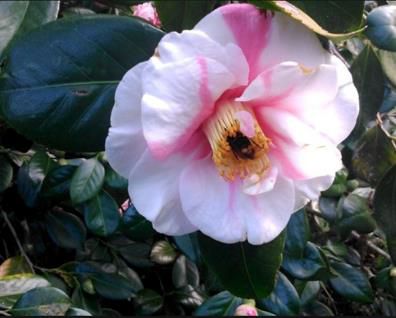|
The April newsletter is out now! If you haven't received your copy - emailed by your Division - you can take a look here.
Among the articles and notices is this update on Asian hornets by our AHAT coordinator Lynne Ingram: Asian Hornets By the time you read this, I hope that we will be experiencing warmer spring temperatures and longer days. As this happens, any hibernating Vespa velutina queens will emerge from their winter hiding places, and start rebuilding their strength by feeding on nectar and tree sap. In Jersey and France queens have been spotted feeding on tree sap from oak trees as well as beech, maple and willow, as well as on single open camellias, so keep an eye on those and other flowers open in your garden. Feeding stimulates the queen’s ovaries to mature, and the nesting instinct increases. Before the foundress queen starts her nest however, research suggests that queens will migrate some distance away, as other species of Vespa are known to do – sometimes in large numbers. It is assumed therefore, that post hibernation migration may be occurring in Europe, which could explain the rapid spread of Vespa velutina across France. Research suggests that Vespa velutina queens are able to fly about 40 km per day. Once the foundress queen has migrated, she will start making a small embryo nest from papier mache. These are generally in a sheltered low level site – in a shed, garage, loft or in a bramble patch. The queen is alone and vulnerable at this time and so conserves her resources. Keep an eye out for these nests – they will be much easier to remove than a large nest 50 foot up in a tree! If you see one, take some time to observe such a nest to make sure it contains Vespa velutina and not a wasp – take a photo of the queen on her nest as evidence, before reporting on Asian Hornet Watch. At this stage it can take up to 50 days from eggs being laid to worker emergence. Once the workers emerge, they will gradually take over many of the roles of foraging, defence and nest building within the colony, leaving the queen to lay eggs. They will enlarge the nest around the embryo nest, as the numbers increase in the colony. This primary nest will continue to grow in size and numbers until mid July when 70% of these nests will relocate into a high tree. For about a month, however, both nests will remain active, until the brood in the primary nest has all emerged. This is when you may start seeing Asian Hornets preying on your bees, as the adults have many hungry larval mouths to feed. The adult hornets hunt for protein for the larvae, and in return receive a sweet substance from the mouths of the older larvae. The adults also collect and eat nectar and tree sap. Remember to keep monitoring your traps daily, releasing any by-catch. At this time of year the queens will not be hawking for bees so traps should be hanging near your kitchen window or somewhere very easy to see. If you see an Asian hornet, the key is to get evidence so that you can report it. The easiest way is to take a photo or video, then email it with details to: [email protected] or use the Asian Hornet Watch app. Somerset Asian Hornet Action Team: If you think you may have seen an Asian Hornet and are struggling to get evidence, or need some advice then contact the Somerset Action team on: [email protected], and someone will come and help with identification and getting evidence. Further contact details for the Somerset AHAT teams are in the Somerset Beekeepers Association Year Book, and on the SBKA website. Comments are closed.
|
Archives
March 2024
Categories
All
|
Somerset Beekeepers Association Charity © 2021 Registered CIO Charity 1206483
Affiliated to the British Beekeepers Association
Click here to view our Privacy Policy
Affiliated to the British Beekeepers Association
Click here to view our Privacy Policy

 RSS Feed
RSS Feed
